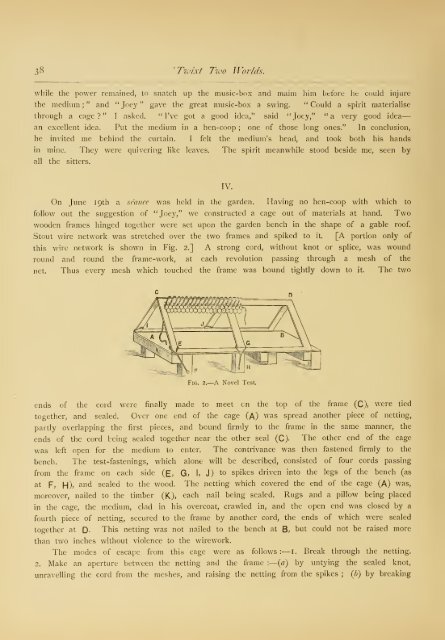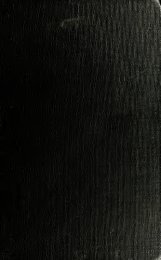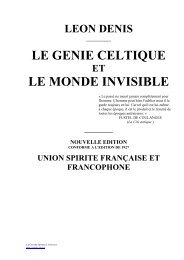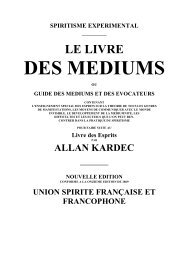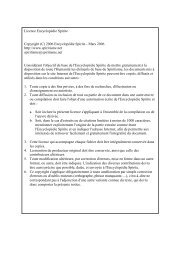'Twixt two worlds : a narrative of the life and work of William Eglinton
'Twixt two worlds : a narrative of the life and work of William Eglinton
'Twixt two worlds : a narrative of the life and work of William Eglinton
Create successful ePaper yourself
Turn your PDF publications into a flip-book with our unique Google optimized e-Paper software.
—<br />
—<br />
\B <strong>'Twixt</strong> Two TJor/t/s.<br />
while <strong>the</strong> power remained, to snatch up <strong>the</strong> music-box <strong>and</strong> maim him before he could injure<br />
<strong>the</strong><br />
;<br />
medium " <strong>and</strong> " Joey " gave <strong>the</strong> great music-box a swing. " Could a spirit materialise<br />
through a cage" I asked. "I've got a good idea," said "Joey," "a very good idea<br />
an excellent idea. Put <strong>the</strong> medium in a hen-coop ; one <strong>of</strong> those long ones." In conclusion,<br />
he invited me behind <strong>the</strong> curtain. I felt <strong>the</strong> medium's head, <strong>and</strong> took both his h<strong>and</strong>s<br />
in mine. They were quivering like leaves. The spirit meanwhile stood beside me, seen by<br />
all <strong>the</strong> sitters.<br />
IV.<br />
On June 19th a seance was held in <strong>the</strong> garden. Having no hen-coop with which to<br />
follow out <strong>the</strong> suggestion <strong>of</strong> "Joey," we constructed a cage out <strong>of</strong> materials at h<strong>and</strong>. Two<br />
wooden frames hinged toge<strong>the</strong>r were set upon <strong>the</strong> garden bench in <strong>the</strong> shape <strong>of</strong> a gable ro<strong>of</strong>.<br />
Stout wire ne<strong>two</strong>rk was stretched over <strong>the</strong> <strong>two</strong> frames <strong>and</strong> spiked to it. [A portion only <strong>of</strong><br />
this wire ne<strong>two</strong>rk is shown in Fig. 2.] A strong cord, without knot or splice, was wound<br />
round <strong>and</strong> round <strong>the</strong> frame-<strong>work</strong>, at each revolution passing through a mesh <strong>of</strong> <strong>the</strong><br />
net. Thus every mesh which touched <strong>the</strong> frame was bound tightly down to it. The <strong>two</strong><br />
Fig. 2.—A Novel Test.<br />
ends <strong>of</strong> <strong>the</strong> cord were finally made to meet en <strong>the</strong> top <strong>of</strong> <strong>the</strong> frame (C), were tied<br />
toge<strong>the</strong>r, <strong>and</strong> sealed. Over one end <strong>of</strong> <strong>the</strong> cage (A) was spread ano<strong>the</strong>r piece <strong>of</strong> netting,<br />
partly overlapping <strong>the</strong> first pieces, <strong>and</strong> bound firmly to <strong>the</strong> frame in <strong>the</strong> same manner, <strong>the</strong><br />
ends <strong>of</strong> <strong>the</strong> cord being sealed toge<strong>the</strong>r near <strong>the</strong> o<strong>the</strong>r seal (C). The o<strong>the</strong>r end <strong>of</strong> <strong>the</strong> cage<br />
was left open for <strong>the</strong> medium to enter. The contrivance was <strong>the</strong>n fastened firmly to <strong>the</strong><br />
bench. The test-fastenings, which alone will be described, consisted <strong>of</strong> four cords passing<br />
from <strong>the</strong> frame on each side (E, G, I, J) t0 spikes driven into <strong>the</strong> legs <strong>of</strong> <strong>the</strong> bench (as<br />
at F, [-)), <strong>and</strong> sealed to <strong>the</strong> wood. The netting which covered <strong>the</strong> end <strong>of</strong> <strong>the</strong> cage (A) was,<br />
moreover, nailed to <strong>the</strong> timber (K), each nail being sealed. Rugs <strong>and</strong> a pillow being placed<br />
in <strong>the</strong> cage, <strong>the</strong> medium, clad in his overcoat, crawled in, <strong>and</strong> <strong>the</strong> open end was closed by a<br />
fourth piece <strong>of</strong> netting, secured to <strong>the</strong> frame by ano<strong>the</strong>r cord, <strong>the</strong> ends <strong>of</strong> which were sealed<br />
toge<strong>the</strong>r at D- This netting was not nailed to <strong>the</strong> bench at B, but could not be raised more<br />
than <strong>two</strong> inches without violence to <strong>the</strong> wire<strong>work</strong>.<br />
The modes <strong>of</strong> escape from this cage were as follows:— 1. Break through <strong>the</strong> netting.<br />
2. Make an aperture between <strong>the</strong> netting <strong>and</strong> <strong>the</strong> frame (a) by untying <strong>the</strong> sealed knot,<br />
:<br />
unravelling <strong>the</strong> cord from <strong>the</strong> meshes, <strong>and</strong> raising <strong>the</strong> netting from <strong>the</strong> spikes ; (6) by breaking


